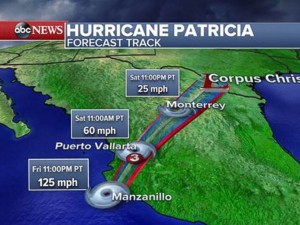5 Questions to Ask Before You Buy a Home in a Hurricane Zone
While Hurricane Patricia didn’t amount to much in the end, it started out as the strongest hurricane on record, making it a stark reminder that living at the beach can be dangerous. It is important for anyone contemplating a move to the beach to think about all of the factors that can impact your safety and budget.
Living on the beach can certainly be magical but it can also be extremely expensive. The following are a few questions anyone who is thinking about moving to the beach should consider before buying a coastal home:
The cost of insurance
Hurricanes can be devastating to coastal communities and in order to ensure that your house and possessions are protected in the event of a catastrophic storm you should consider hurricane insurance. The top coastal counties most frequently hit by hurricanes from 1960 to 2008 include:
| County | State | Coastline region | Number of hurricanes | Percent change in population, 1960-2008 |
|---|---|---|---|---|
| Monroe County | Florida | Gulf of Mexico | 15 | 50.8% |
| Lafourche Parish | Louisiana | Gulf of Mexico | 14 | 67.2 |
| Carteret County | North Carolina | Atlantic | 14 | 104.3 |
| 13 | 465.9 | |||
| Hyde County | North Carolina | Atlantic | 13 | 10.1 |
| Jefferson Parish | Louisiana | Gulf of Mexico | 12 | 108.9 |
| Palm Beach County | Florida | Atlantic | 12 | 454.7 |
| Miami-Dade County | Florida | Atlantic | 11 | 156.5 |
| St. Bernard Parish | Louisiana | Gulf of Mexico | 11 | 17.2 |
| Cameron Parish | Louisiana | Gulf of Mexico | 11 | 4.8 |
| Terrebonne Parish | Louisiana | Gulf of Mexico | 11 | 78.7 |
Source: U.S. Department of Commerce, Census Bureau, Decennial Census of Population and Housing: 1960 to 2000; Population Estimates Program: 2008.
Before purchasing a home that is located near the coast or in a hurricane prone area, check with your insurance agent in regards to the cost of a homeowners policy as well as additional hurricane coverage. Prepare to be shocked, the cost increase can be dramatic, especially if you are coming from a more inland location. Remember, flood damage is not covered by a standard homeowners policy so getting a quote for a flood policy is recommended as well.
Is beachfront worth it?
Where you decide to buy will have an impact on your insurance premium. Obviously beachfront homes are at the highest risk and will cost the most to insure. Moving a few blocks or miles inland can make a dramatic difference in your insurance premiums.
Using flood insurance rate maps that are issued by the National Flood Insurance Program should help you determine how much you can expect to pay for a flood policy. The highest risk areas on the maps are referred to as Special Flood Hazard Areas. In these locations the risk of flood damage is 1 in 4 over the course of a 30- year mortgage.
The type of home matters
The type of home you buy can affect your expenses as well as the ability of your house to withstand the extreme winds of a hurricane. Homes that have a dome-shape are less likely to experience wind damage. If you plan on living in a flood risk area a house on stilts can dramatically reduce flood damage.
When shopping for a home ask your agent to show you homes that have been specifically designed to withstand hurricane winds. If the home is not built to hurricane standards it is wise to bring in a contractor to improve the strength of your house. Certain improvements can have an effect on your insurance premiums, putting your house on stilts or installing hurricane shutters can drastically lower your premium.
Deductibles can be high
Regardless of where your home is located, hurricane damage is covered by a standard homeowner policy. Unfortunately, when it comes to hurricane related damage your deductible may increase dramatically.
While damage from wind is covered by a standard homeowners policy, many policies have an additional clause that relates to hurricane damage. In most cases there is a special deductible that applies to hurricane damage that is separate from the normal policy deductible.
Hurricane deductibles are often set as a percentage of the insured value of the home, often running between 3% and 5%. This can dramatically increase the deductible amount that you have to cover.
The deductible amount varies by insurance company so shopping around is the best way to find a deal. When shopping for coverage, specifically ask about the deductible for hurricane damage. The difference between 3% and 5% can be dramatic.
What about flood insurance?
Almost all coastal homes are located in a high-risk flood area. While a homeowners policy covers wind and rain damage related to hurricanes, it does not cover damage due to flooding.
A flood insurance policy, which is issued by the National Flood Insurance Program will ensure that you are fully covered in the event of flood damage. While regular insurance companies sell these policies, the federal government sets rates so there is no need to shop on price, look for an insurance company that offers high levels of customer service.
Flood insurance can be expensive so prior to purchasing a home in a coastal region it is a good idea to get a flood insurance quote so that you fully understand the cost of beachfront home ownership.

